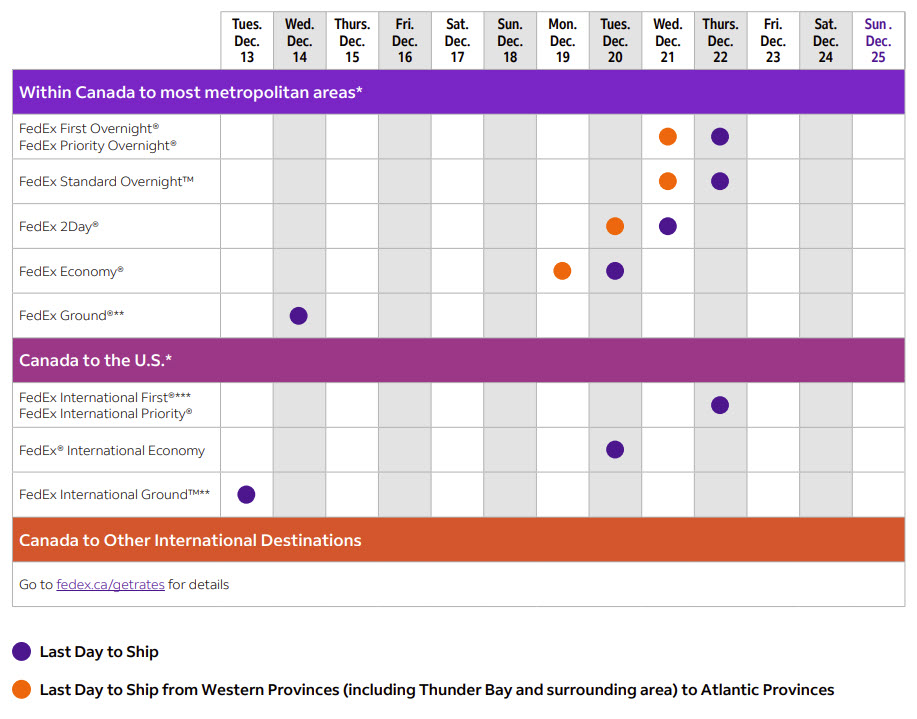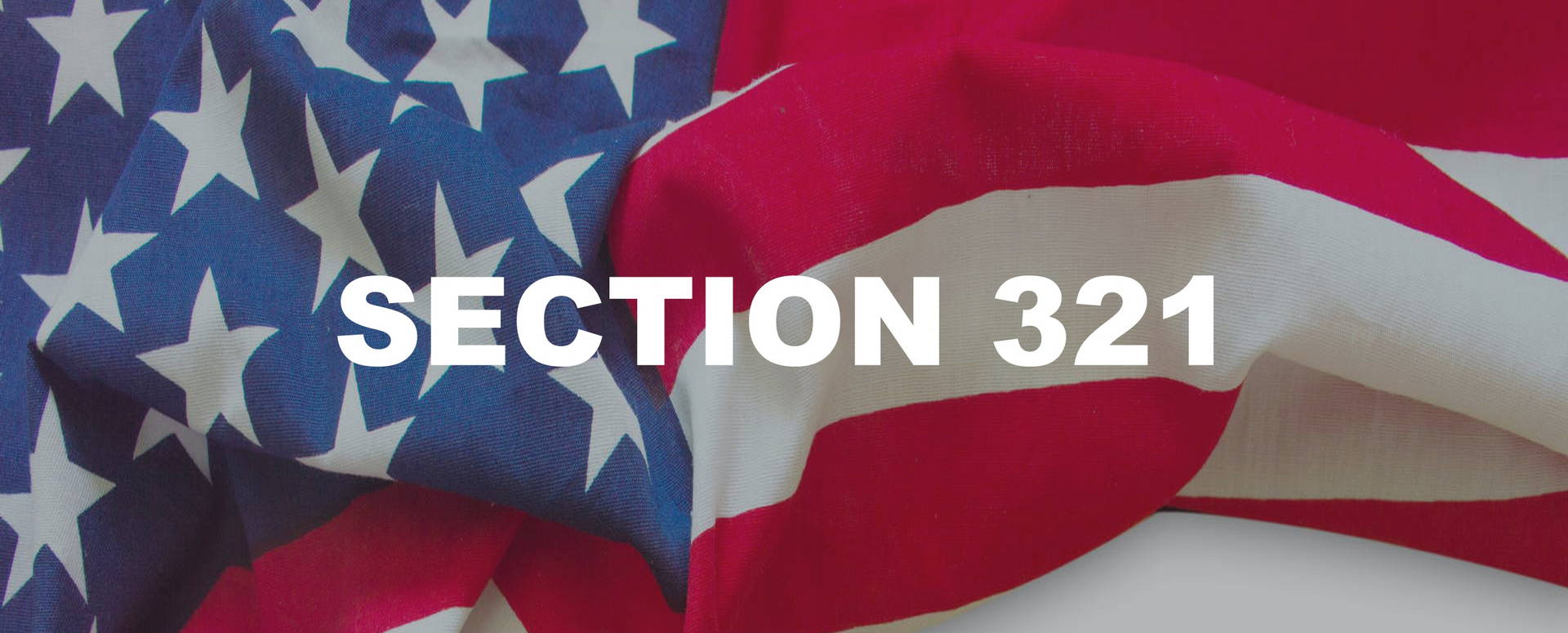

1615 Inkster Blvd.
Winnipeg, Manitoba R2X 1R2
(204) 471-8251
sales@kitpak.com


1615 Inkster Blvd.
Winnipeg, Manitoba R2X 1R2
(204) 471-8251
sales@kitpak.com

Once again, it is that time of year when sales ramp up and your customers rely on you more than ever, to get their orders delivered before Christmas. This year, with the ever-increasing volume of online sales, carriers are working diligently to ensure your important shipment is delivered on-time. With global supply chain bottlenecks starting to ease and with local weather that has cooperated so far, we are looking forward to a smooth and trouble-free Christmas shipping season.
While some uncertainty still exists in the supply chain caused by factors out of their control, most carriers will provide guidance on cut-off dates for Christmas delivery, but without the normal guarantee.
Below are the Christmas cut-off dates from several commonly used carriers. This information is provided as a guideline only. For additional information, please contact Kitpak Fulfillment today.


Here are some important UPS shipping deadlines for you to plan around, in order to get your shipments delivered before Christmas.
Note: Dates are subject to change

Kitpak Fulfillment is a leading provider of e-commerce fulfillment services to many online merchants and will ship products throughout Canada and the USA. For more information on how Kitpak can help streamline your fulfillment process and save you money CONTACT US or REQUEST a QUOTE today.

1615 Inkster Blvd.
Winnipeg, Manitoba R2X 1R2
(204) 471-8251
sales@kitpak.com

Traditional multi-channel sales used to mean that a retailer would sell their goods in several places including in their bricks and mortar store, through their website, through mail-order catalogues and perhaps through telephone sales. The advantage of multi-channel sales is that it can make it easier for your customers to purchase your products. For example, some elderly customers may not be online or comfortable purchasing online so other sales channels are necessary in order to reach them. Likewise, specific disabled customers may find it impossible to visit a physical store so an online presence is necessary to make your products available to them.
In today’s evolving business to consumer retail environment, many businesses have never even had a physical location and sell their products online only. So, what does multi-channel sales look like for these businesses? Like traditional multi-channel sales, it means making your products widely available to customers in your market, wherever they tend to do their shopping.
A website is a great place to start. If you have a business and now want to start marketing and selling products online, your existing website is a good place to start. Today it is relatively easy and inexpensive to add an online catalogue and shopping cart to your website. Add a payment processor to receive online payments from your customer and you are in business.
An e-commerce enabled website alone does not guarantee sales. You also need to ensure that your business and products are found when a potential customer searches for something you sell. If you do not rank well in search results, sales will not happen. To generate traffic to your store, you may need to expend a significant amount of time and money (SEO, paid ads, etc.).
When a potential customer finds your online store, the next function of your store is to convert that visitor into a customer. With so many online options today, what can you do to make the customer want to buy from you? Here are a few items to consider:
To complement online sales through your own website, many online businesses have greatly extended their reach by making their products available through a variety of online marketplaces. A key advantage of selling through online marketplaces is that shoppers can search for and purchase products from multiple unrelated vendors without ever leaving the one site. This is the modern-day online equivalent of the regional mega shopping centers. There are some very strong marketplace options available for merchants to consider.

Amazon is the world’s largest online marketplace generating an estimated $465+ billion in sales in 2021 ($1.25+ billion every day). One key advantage of selling through Amazon is the sheer volume of traffic that they generate. It is estimated that 90% of online shoppers price check products on Amazon. Many of your potential customers could be searching through Amazon right now for your products and if you are not there, your Amazon competitors will get the sales.
eBay is a well-established online marketplace that could provide a valuable outlet for your products. With an estimated 187 million global users, eBay offers a broad reach. Many people believe that eBay is for sales of used products, but approximately 80% of products sold on eBay are new products and 16% fall into the electronics/accessories market.
Shopify, with an estimated average of 2.1 million daily users, has continued to follow its mission to make it easier for merchants to reach more buyers while building strong customer relationships. They have simplified commerce for merchants allowing them to concentrate on what is key to their business and not worry about the e-commerce infrastructure.
Etsy is a growing online marketplace with 80+ million active buyers. Etsy does a good job of uniting buyers and sellers with their top categories including: homewares and furnishings; jewelry and accessories; craft supplies; apparel; paper and party supplies; personal care products.
Wayfair, with revenue of $13.5+ billion, has more than 27 million active users. The top product category is Furniture and Appliance where they rank 4th in the US behind Amazon, Home Depot and Walmart. Wayfair could be a great option if your products fall into Wayfair’s market sweet spot.
Walmart has grown their 3rd party sellers to more than 130,000 with a wide range of products in 30+ product categories. With an estimated 32+ million users, Walmart offers broad exposure for your product. One cautionary note is that your pricing must fall within Walmart’s Low Price Guarantee or risk delisting.
Kitpak Fulfillment’s robust system software will seamlessly integrate with all the above-mentioned online marketplaces, allowing Kitpak to be your single-source fulfillment partner no matter where you choose to sell your products.
To learn more about Kitpak Fulfillment and how we can streamline your e-commerce fulfillment services and reduce your costs, please CONTACT US today or REQUEST A QUOTE.

1615 Inkster Blvd.
Winnipeg, Manitoba R2X 1R2
(204) 471-8251
sales@kitpak.com

Generally speaking, when a customer in the U.S. purchases a low-value product from abroad, the importation process can be streamlined and less costly thanks to the Section 321 program.
The Trade Facilitation and Trade Enforcement Act of 2015 (TFTEA) was signed into law P.L. 114-125 on February 24, 2016. It is the first comprehensive authorization of U.S. Customs and Border Protection (CBP) since the Department of Homeland Security was created in 2003, with the overall objective to ensure a fair and competitive trade environment
The underlying objective of the TFTEA is: Helping American workers and American businesses compete fairly with the rest of the world.
With the exponential growth of the online shopping market in the United States over the past five years, CBP has seen a significant increase in small, low-value packages. In fact, today CBP processes more than 600 million express consignment and international mail shipments a year – approximately 1.8 million a day. The unprecedented growth in volume of these low-value shipments requires creative solutions to prevent illicit and dangerous products from entering the United States, including illicit narcotics, unregulated prescription drugs, brand counterfeits, and unsafe food and beauty products.
All participants must transmit certain required data elements to CBP for the Section 321 Data Pilot. Moreover, CBP has given participants the flexibility to transmit optional data elements as they are able to test the viability of sharing additional information. This information will help CBP ascertain data which are key indicators of compliance with U.S. trade laws and consumer safety. With these additional details, CBP will be able to focus more resources on high-risk shipments while expediting the clearance of legitimate shipments.
As a result of TFTEA provisions, Customs and Border Protection raised the de minimis value, i.e., value of a shipment of merchandise imported into the U.S. by one person in one day that generally may be imported free of duties and taxes, from USD $200 to USD $800 per shipment.
Section 321(a)(2)(C) of the Tariff Act of 1930, as amended, authorizes CBP to provide an administrative exemption to admit free from duty and tax shipments of merchandise (other than bona fide gifts and certain personal and household goods) imported by one person on one day having an aggregate fair retail value in the country of shipment of not more than USD $800. This exemption is known as a de minimis entry. CBP has created Section 321 programs to enable the agency to monitor and protect against illegitimate trade while providing the public the benefits of duty-free shipments for qualified imports.
Generally speaking, when a customer in the U.S. purchases a low-value product from abroad, the importation process can be streamlined and less costly thanks to the Section 321 program. The program is designed to facilitate the faster clearance of shipments arriving at the U.S. border while also enhancing the ability of U.S. Customs and Border Protection to identify and inspect potentially illegitimate or violative shipments. This helps the importer of goods by allowing for faster clearance of shipments at the border and aids the CBP in protecting against illegal importations.
There are exceptions to Section 321 that limit certain types of importations such as: alcoholic beverages; tobacco products; textiles; goods subject to inspection; commodities subject to tariff-rate quotas; goods subject to Anti-Dumping (ADD) and Countervailing Duty (CVD); and more.
For detailed information about the Section 321 program, please visit the U.S. Customs and Border Protection website:
To find out if your products can be imported into the U.S. duty and tax free under Section 321, please CONTACT US at Kitpak Fulfillment today for a comprehensive review of your fulfillment requirements.

1615 Inkster Blvd.
Winnipeg, Manitoba R2X 1R2
(204) 471-8251
sales@kitpak.com